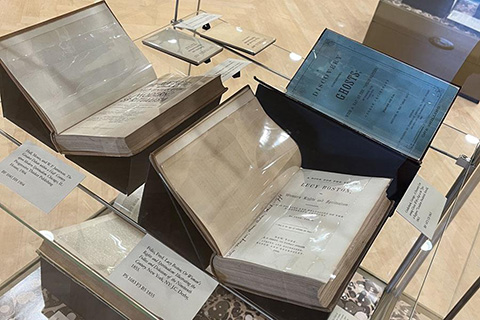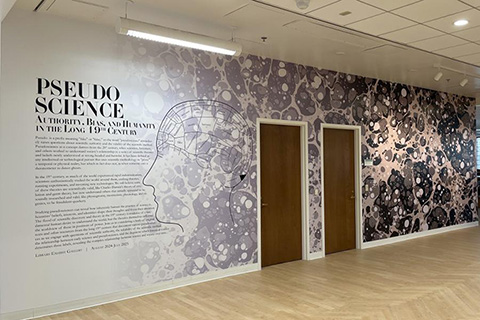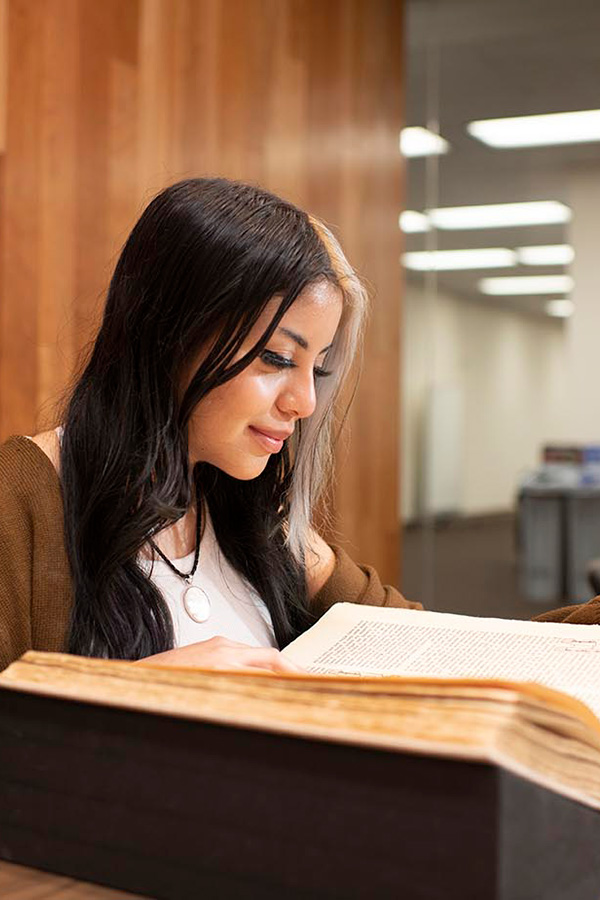Newsletter Edition: Fall 2024
Contributed by Mallory Furnier and Ellen Jarosz
The Special Collections & Archives exhibit Pseudoscience: Authority, Bias, and Humanity in the Long 19th Century, opened In August 2024. The exhibit explores the history of science as a practice, highlights selected pseudoscientific trends, and makes us think about how we evaluate and use what we presume to be authoritative knowledge. Special Collections & Archives Head Ellen Jarosz and Librarian Mallory Furnier provide insights that will help visitors get the most out of the displays.
What are the goals of the Pseudoscience exhibit?

The exhibit provides an opportunity to highlight the breadth of our 19th century book collection, to encourage viewers to critically approach an information source, and to explore and consider the nature of authority and its role in determining what becomes culturally accepted as truth.
How do you think presenting these 19th century books in the context of Pseudoscience put them in a new light?
Words in print are often accepted as settled and reliable truth. Additionally, the appearance of an "old" and "valuable" book that has been well cared for over decades (or centuries) can cause people to perceive its contents as authoritative. In curating this exhibit, we hoped to challenge those assumptions we all make, often without even realizing it. Our goal is for exhibit viewers to regard these printed works with the same degree of skepticism they might when reading much of what is printed today on the internet, ultimately consuming them as sources not inherently reliable, despite their appearance. Displaying these books in the context of our Pseudoscience exhibit provides an important reminder to always consider the source of information and what kind of bias authors and readers like ourselves likely had.
What does this exhibit give the visitor to think about, regarding accepted or legitimate science?
“Science,” as we know it, is a relatively new methodology for validating information. What constitutes “scientific method” is still debated, and our Western ways of knowing and classifying the world are heavily biased and often practiced with harmful results. Knowledge can be pursued for virtuous and beneficial purposes, but it can also be wielded as a weapon of control.
“Scientist” was not a profession until the early 19th century. Prior to that time there were heavy religious influences that determined what should be accepted as truth. Those that sought to understand the ways in which the world works were instead known as “philosophers.” There are throughlines in several disciplines from philosopher-science and scientist-science (for example, from astrology to astronomy). Ultimately, all of this inquiry is bound together by millennia of humans wanting to understand how things work.
There is a large section on the topic of eugenics – what did you want the display to show people about that topic, specifically?
That portion of the exhibit is so large in part because eugenicists were very concerned with female reproductive health and various methods of birth control. We have extensive collections on human sexuality and gender here at CSUN that include many historical sources on those same subjects, and so over the decades our collection has grown to include many publications produced by eugenicists, among others.

The extent to which eugenic ideas were carried out in both US and Europe and their devastating consequences is extraordinarily dark history. We often found ourselves having to take breaks while writing that section of the exhibit when we learned new horrible details about this history ourselves, but the legacy of the movement is complex. Those who believed and applied its central tenets caused millions of deaths and forced sterilizations around the world. Scholars also acknowledge eugenic studies contributed to a scientific climate in the early 20th century that ultimately increased the study of female reproductive health, lowered infant mortality rates, developed safe and effective birth control methods, and made other medical advancements we generally regard as positive in modern society.
As we’ve already stated, one of the central themes we wanted to engage with in the exhibit was to critically approach sources that appear authoritative, endeavoring to engage with them fully and honestly. An honest engagement with the history of the eugenics movement is challenging, but the history also highlights the challenges of pseudoscientific beliefs in historical context more broadly. Eugenic ideas were never scientifically valid, but also can't be easily dismissed as a meaningless historical blip society has now moved past.
What will visitors discover about the role California played in the proliferation of pseudoscientific health practices?
The scope of our 19th century book collection is loosely American and British, with a touch of Western Europe. The hydropathy case focuses on water-based treatments for pain and other ailments. There were quite a few items in our California Tourism and Promotional Literature Collection that extolled the virtues of water at a number of California springs in the late 19th and early 20th centuries. California has long been advertised as a place to come for health benefits (whether proven as scientific or not), and that comes through in the exhibit.
How do you think Pseudoscience might be incorporated into CSUN instruction?
Pseudoscience presents texts that were often accepted and presented as “truth” at their time of publication. In our era of “fake news” it is important to remember that texts from any time, past or present, require critical and skeptical engagement from their readers to be fully examined, whether by questioning the source of information, working to uncover bias, exploring the context in which the content was created, or even by considering your own reactions to the content as a reader.
What did you have to leave out of the exhibit and why?
It would’ve been great to incorporate non-Western ways of knowing and thinking, but we were limited by our collection holdings. Although we do have a few items, there weren’t enough to fully interrogate and contextualize the texts in a way that would be respectful and meaningful within the scope of this specific exhibit. We were similarly limited in exploring some additional pseudoscientific beliefs like iridology, dowsing, divination, and more by an absence of items in our collections on those and other topics.
The Pseudoscience: Authority, Bias, and Humanity in The Long 19th Century runs from August 26, 2024 through July 28, 2025. Take a peek and learn more about the exhibit!

